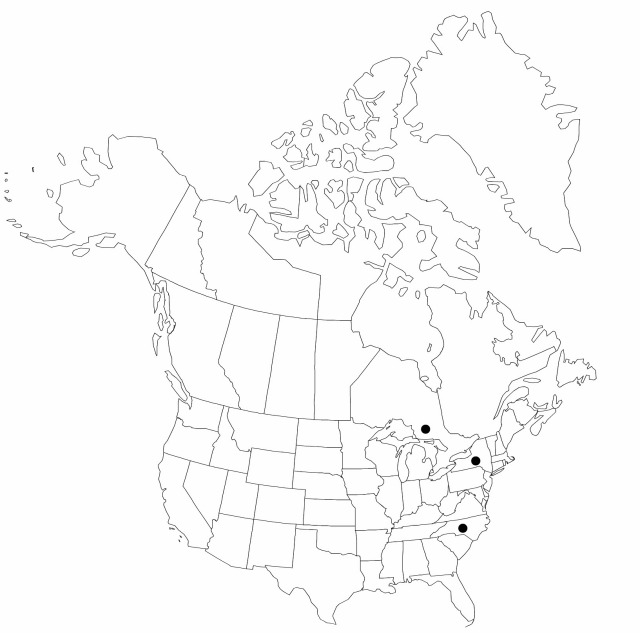Difference between revisions of "Carex sylvatica"
Fl. Angl., 353. 1762.
FNA>Volume Importer |
imported>Volume Importer |
||
| (One intermediate revision by the same user not shown) | |||
| Line 8: | Line 8: | ||
}} | }} | ||
|common_names=European woodland sedge | |common_names=European woodland sedge | ||
| + | |special_status={{Treatment/ID/Special_status | ||
| + | |code=I | ||
| + | |label=Introduced | ||
| + | }}{{Treatment/ID/Special_status | ||
| + | |code=F | ||
| + | |label=Illustrated | ||
| + | }} | ||
|basionyms= | |basionyms= | ||
|synonyms= | |synonyms= | ||
| Line 23: | Line 30: | ||
|habitat=Disturbed areas in deciduous forests | |habitat=Disturbed areas in deciduous forests | ||
|distribution=Ont.;N.Y.;N.C.;Europe;introduced New Zealand. | |distribution=Ont.;N.Y.;N.C.;Europe;introduced New Zealand. | ||
| + | |introduced=true | ||
|discussion=<p>No hybrids are reported in the flora, although in Europe <i>Carex sylvatica</i> hybridizes with C. strigosa and <i>C. hirta</i>.</p> | |discussion=<p>No hybrids are reported in the flora, although in Europe <i>Carex sylvatica</i> hybridizes with C. strigosa and <i>C. hirta</i>.</p> | ||
|tables= | |tables= | ||
| Line 45: | Line 53: | ||
|publication title=Fl. Angl., | |publication title=Fl. Angl., | ||
|publication year=1762 | |publication year=1762 | ||
| − | |special status= | + | |special status=Introduced;Illustrated |
| − | |source xml=https:// | + | |source xml=https://bitbucket.org/aafc-mbb/fna-data-curation/src/2e0870ddd59836b60bcf96646a41e87ea5a5943a/coarse_grained_fna_xml/V23/V23_867.xml |
|genus=Carex | |genus=Carex | ||
|section=Carex sect. Hymenochlaenae | |section=Carex sect. Hymenochlaenae | ||
Latest revision as of 21:43, 5 November 2020
Plants densely cespitose. Culms pale brown to ivory at base, sometimes with a few brown fibrillose remains of previous year’s leaves, but not densely covered with fibrils; flowering stems 25–110(–200) cm, longer than leaves at maturity, 1–1.3 mm thick, glabrous. Leaves: sheaths glabrous, proximal ones ivory grading distally to light green, all bearing blades, pale hyaline on front; blades flat, (3–)5.5–8.5(–15) mm wide, glabrous on both surfaces, finely scabrous on margins. Inflorescences: peduncles of lateral spikes 5–20 mm, scabrous; peduncle of terminal spike less than 20 mm, scabrous; proximal bracts usually shorter than entire inflorescence; sheaths 20–100 mm; blades 2–3 mm wide. Lateral spikes: 3–5, 1 per node, the proximal well separated, erect to somewhat nodding, distal ones crowded near apex; proximal spikes pistillate with 15–40 spreading perigynia attached 1–1.5 mm apart, cylindric to elongate, 15–60 × 3–5 mm; distal spikes staminate or androgynous. Terminal spike staminate or androgynous with a few pistillate flowers at base, 15–40 × 2.5–3 mm. Pistillate scales white-hyaline with broad green midrib, oblong-lanceolate, shorter than mature perigynia, apex acute, cuspidate, or awned, glabrous. Perigynia green maturing to light brown, conspicuously 2-ribbed but otherwise veinless except for short inconpicuous veins at base, substipitate, tightly enveloping achene, obovoid, 4.5–6 × 1.4–1.8 mm, membranous, apex abruptly narrowed to tubular beak, glabrous; beak bidentate, slender, 2–3 mm, teeth 1 mm. Achenes sessile, 2.2–2.6 × 1.2–1.5 mm. 2n = 58 (Czechoslovakia, Germany, Great Britain, Iberian Peninsula, Poland, Sweden)
Phenology: Fruiting summer.
Habitat: Disturbed areas in deciduous forests
Distribution

Introduced; Ont., N.Y., N.C., Europe, introduced New Zealand.
Discussion
No hybrids are reported in the flora, although in Europe Carex sylvatica hybridizes with C. strigosa and C. hirta.
Selected References
None.
